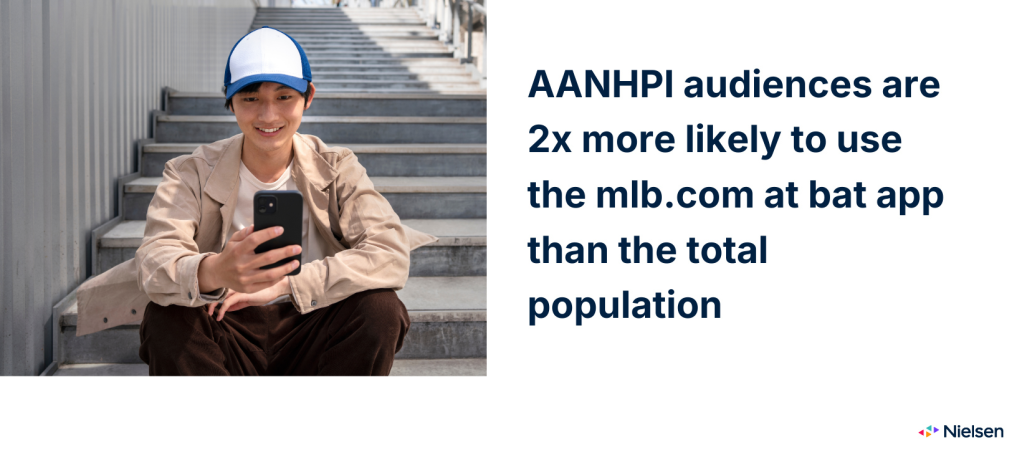Baseball is having a cultural moment—and Nielsen data shows that much of it is being driven by fans who see the sport as more than a game. Multicultural audiences are changing how, where, and why fans connect, making sports one of the most powerful platforms for representation, community, and culture. From Tokyo to Los Angeles, baseball is becoming a vibrant example of cultural fusion, with Asian fans leading the charge.
For years, marketers have known that sports drive engagement. And that’s especially true for Asian American, Native Hawaiian, and Pacific Islander (AANHPI) audiences. According to Nielsen’s latest Diverse Intelligence Series Report, while AANHPI audiences spend less time with TV overall, when they do tune in, they’re spending a larger share of their linear TV time watching live sports compared to the total population.
Asian American fans are also 33% more likely to subscribe to sports-focused streaming services, based on Nielsen Attitude on Ads study. In addition, they’re highly engaged across apps like MLB.com At Bat and BetMGM, driving real-time interaction around the games they love.

AANHPI audiences are gravitating toward sports that center players who look like them, speak their languages, and represent their cultures. Shohei Ohtani, the LA Dodgers’ star player from Japan, helped drive Asian American viewership. The 2024 World Series had a remarkable average of 15.2 million viewers, with Asian American viewing increasing 146% over the 2023 World Series.
Nowhere is the intersection of culture and sports more visible—or more culturally electric—than in Los Angeles. Whether it’s the authentic Japanese flavors available at concessions or the mash-up of African American and Mexican music, multicultural fandom is front and center at Dodger Stadium.
Attendance also rose for Latino audiences at Dodgers games between 2019 and 2024, with the composition of Latino fans increasing by 3%. This is sustained, measurable momentum—and it’s creating a new baseline for audience expectations.
For advertisers, this moment offers more than just cultural visibility. Sports offers a brand-safe, emotionally resonant media environment with a real-time viewing experience that draws in co-viewing, live engagement, and multigenerational audiences. For diverse segments, that engagement is even more meaningful—because it’s anchored in identity, community and celebration.
All of this is amplified by global events like the MLB Tokyo Series. Ohtani led the Dodgers in the 2025 international season opener, driving a 113% spike in AANHPI viewership over the prior year’s MLB Seoul Series. Black, Hispanic and total audiences also grew their viewing for this international event, year-over-year, increasing 111%, more than 200% and 107%, respectively. This momentum is echoing back home, shaping not just fandom but consumer behavior, from streaming preferences to merchandise sales.
These global sports moments are having local impact. Fans are tuning in, showing up, and sharing cultural pride in unique ways—whether it’s sneakers commemorating Jackie Robinson Day or anime-patched jerseys. Events like Japanese Heritage Night at Dodger Stadium lean in even further, providing full-sensory experiences with stadium menus that blend Japanese flavors with Dodger Dogs and exclusive merch featuring world-renowned artist Takashi Murakami that sold out almost instantly. The stadium came alive with Japanese music, cuisine and colors—and the crowd reflected LA’s true makeup: Fans with diverse cultural backgrounds standing shoulder to shoulder, celebrating a passion for sports and culture.
When fans feel represented, they respond. Nielsen’s Attitudes on Representation study found that 59% of AAPI audiences say they wish they saw more representation of their identity group when they watch TV. And Asian American Gen X are 48% more likely to buy from brands that advertise in programming that feature someone from their identity group. Not to mention, Asian Americans who speak a language other than English told us their brand affinity grows when ads are delivered in their language. Representation improves brand recall, favorability and purchase intent.
For brands, networks, and advertisers, this is a moment to reimagine the fanbase—not as a static demographic segment, but as an evolving cultural force. Sports, particularly baseball in LA, is no longer about appealing to “target groups” in isolation. It’s about understanding where cultural connections overlap—and building campaigns, content, and partnerships that reflect that.
For more insights into today’s AANHPI fans and how to connect with them, check out our report Breakthrough ROI: Investing in Asian American audiences and media.



